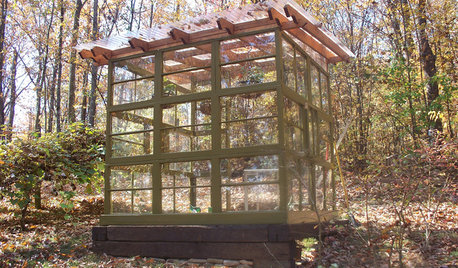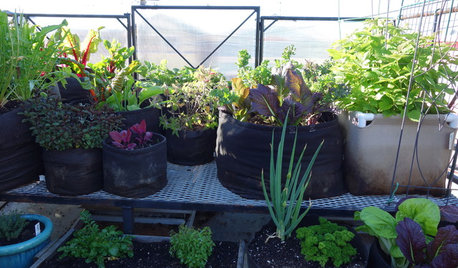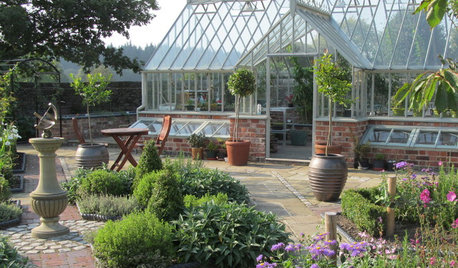I was asked to write this up for a local presentation sponsored by Texas A&M Extension. I'm sorry it's a really long post but maybe someone will find it worth reading.
Growing Fruit in Southwest Texas
Greenhouse Production
West Texas above 4,500ft elevation is ideally suited to greenhouse production of many fruits. Summers are cool and dry enough that greenhouse temperatures can be held in the ideal range. Winters are mild enough that heating costs are reasonable. A greenhouse of 1728 sq ft in Alpine, Texas costs about $50 per month for cooling and $300 per year for heating to 39F.
Soil is a very well drained, deep, clay loam with moderate water holding capacity.
Winter chilling requires about 10-12 weeks with nights at 38-40F and days as cool as possible, about 55-60F. Winter chilling is aided by shade cloth and evaporative cooling. The crops requiring most chilling hours are sweet cherries and some apricots. The other fruits discussed need eight weeks of chilling or less.
Summer cooling is achieved via wet wall and opposing 36 inch exhaust fans. The high temperatures in summer can be held below 95 F in a greenhouse in Alpine.
All greenhouse fruit species listed have been grown both in-ground and in 5-15 gallon pots. Fruit quality can be superb from potted trees but it is more variable and the fruit is smaller. Brix levels listed are for in-ground trees mostly on Citation and Gisela 5 rootstocks spaced from 6ft by 8ft to 4ft by 3ft. Citation is precocious and increases fruit size but is very susceptible to crown gall. Grapes and figs are too vigorous planted in-ground in the greenhouse. Potting makes them much more manageable.
The key management issue for highest fruit eating quality is water. Limiting water lowers the water content of fruit and enhances both sweetness and flavor. Greenhouse average total water application is 28 inches per year. This equates to 1.0 inch every 10-21 days from May thru September (via drip) plus 7-8 inches by flooding in the dormant season, usually October or November, to leach salts and rewet the soil profile.
The watering regime could be described as deficit irrigation. The idea is to force the plant to adapt to a water deficit in spring by withholding irrigation until growth nearly ceases and then maintaining a water deficit all summer. The trees don't usually stop growing entirely in summer but growth is very limited. The water deficit has been taken too far if the trees begin to drop leaves or the fruit shrivels. This watering regime is most suitable and effective for the long season and late maturing grapes, pluot, and nectarine. It's suitable only for the very drought tolerant fruits outdoors; mainly grapes, jujube, and figs.
The floor of the greenhouse is covered with Extenday reflective fabric to increase light in the canopy, control weeds, and save water. This in part accounts for low greenhouse water needs. Light in the greenhouse is highly diffused by IRAC poly and ground fabric but is probably only 40 to 50% total PAR compared to outdoors.
Little or no fertilizer is applied to greenhouse fruits. It's generally not needed since the fruit trees aren't competing with any ground cover vegetation.
Average brix levels have been 18-25 for pluots and nectarines, 24-32 for sweet cherry, and 16-22 for apricots. Fruit size is generally good despite limiting water as much as possible. Flavor King pluot sometimes averages 200 grams and several nectarines 3-4 inches, ~300-450 grams. Fruit size is reduced at the greatest water deficits. For instance nectarines running ~28 brix at higher water deficits are 50-70% the size of 18-22 brix fruit.
Key pest is spider mites which build up in late May. There are many new miticides available for control.
The authors single most favorite fruit is Honey Royale nectarine for it's sweet and incredibly rich flavor. Other favorites are the other Honey and Arctic series nectarines, Orangered and Robada apricot, Flavor Supreme and Flavor King pluot, Strawberry Verte fig, Sweetcrisp blueberry, and Summer Royal grape. Summer Muscat is a great tasting grape but has small berries and cracks.
Greenhouse crops and favorite cultivars
Nectarine: Honey May, Arctic Star, Honey Fire, Arctic Jay, Honey Blaze, Honey Royale, and Honey Diva
Apricot: Tomcot, Robada, Orangered, and Golden Sweet
Fig: Strawberry Verte
Pluots: Flavor Supreme, Flavor King, Crimson Royale, Honey Punch, Flavor Finale, and Flavor Treat
Sweet cherry: Lapins, Van, Bing, Selah, Sandra Rose, and Skeena
Grapes: Flame, Summer Royal, Princess, and Crimson
Citrus: Washington navel and Cara Cara navel
Blueberries: Sweetcrisp and Springhigh
Blackberry: Black Diamond
Peach: Valley Sweet
Outdoor Fruit Production
West Texas has many issues related to growing fruit outdoors. Freezes, hail, and shallow, high pH soils limit production. Soils less than 3 feet deep can severely limit tree growth. These shallow soils are often high in free lime causing iron chlorosis.
Yield, especially of early blooming fruits, is much less outdoors than in the greenhouse. But there are fruits that produce fairly well outdoors: apples, pears, jujube, blackberry, and at lower elevations peach, persimmon, pomegranate, and figs. Watermelons and cantaloupes are also well adapted especially at lower elevations.
Many apple cultivars suffer from lack of chilling but still bear fruit. Pears generally need less chilling but some low chilling cultivars bloom too early. Bosc and Comice take 5-8 years to start bearing. Asian pears and Harrow Sweet bear in 2-3 years.
The late blooming fruits are persimmon, jujube, blackberry, mulberry, and grapes. This may help escape the late freezes but once growth begins they are very freeze sensitive.
Watering needs of outdoors fruits vary considerably. Unlike in the greenhouse where deficit irrigation is successful on stone fruit, the most common situation outdoors is insufficient irrigation. This results in small trees and small fruit especially on shallow soils. Apples, pears, peach, blackberry, and watermelons require about 2.0 inches per week during hot dry periods. Grapes, figs, and jujube can be grown with much less water.
Nitrogen is the most commonly need fertilizer. The amount needed varies widely depending on soil permeability, irrigation amount, and crop. Ammonium sulfate, 21-0-0, is a good nitrogen source for west Texas. Young trees on permeable soil may need nitrogen every month to maximize growth. Older trees usually need nitrogen only 1-3 times per year.
Favorite Outdoor Cultivars
Apples: Gala, Jonalicious, Golden Delicious, Fuji, and GoldRush
Pears: Seckel, Harrow Sweet, Bartlett, Comice, Bosc, and Korean Giant aka Olympic
Grapes: Flame, Summer Royal, Princess, and Crimson
Apricot: Tomcot, Robada, and Orangered
Sweet cherry: Lapins
Peaches: check Texas Aggie Hort
Persimmon: Eureka
Jujube: Sugar Cane, Li, and Lang
Blackberry: Navajo and Triple Crown for thornless
Blueberries: Star and Legacy
Watermelon: Star Brite
Potted Fruits
Blueberries and figs are well suited to 5-15 gallon pots. Blueberries because they need low pH soil and figs for freeze protection and season extension. Figs are marginally hardy at best when planted outdoors in Alpine.
Blueberries need pH ~4.5 and well-draining media. Sphagnum peat moss is probably the best media for the bulk of the potting mix. Water only with rainwater or acidified well water. Untreated well water will kill blueberry plants in one growing season. Treat well water with vinegar or sulfuric acid to pH 4.5. Most West Texas soils are difficult or impossible to acidify to a pH suitable for blueberry.
Table 1. Greenhouse pluot evaluation
Cultivar Harvest Brix Flavor
Flavor Supreme 6-1 24 9
Geo Pride 7-1 24 8
Emerald Drop 7-8 23 7
Flavor Queen 7-15 24 5
Flavor King 7-21 20 10
Flavor Grenade 7-21 24 7
Crimson Royale 8-1 24 8
Honey Punch 8-21 25 8
Flavor Finale 9-1 24 9
Flavor Treat 9-28 24 8
Table 2. Greenhouse apricot evaluation
Cultivar Harvest Brix Flavor
Tasty Rich 4-15 18 7
Honey Rich 4-21 16 6
Tomcot 5-1 20 8
Robada 5-10 22 9
Orangered 5-21 21 10
Golden Sweet 5-28 22 7
Table 3. Greenhouse nectarine evaluation
Cultivar Harvest Brix Flavor
Honey May 5-15 18 7
Arctic Star 6-1 24 9
Arctic Sweet 6-15 23 8
Arctic Jay 7-1 24 8
Honey Fire 7-1 24 8
Honey Blaze 7-1 25 9
Spicezee 7-8 24 8
Honey Royale 7-15 23 10
Honey Diva 8-1 24 9
Valley Sweet peach 8-15 20 8
Arctic Snow 9-1 22 7
Table 4. Greenhouse grape evaluation
Cultivar Harvest Brix Flavor
Flame 7-1 25 7
Summer Muscat 7-15 30 10
Summer Royal 7-21 26 8
Princess 8-1 24 7
Autumn Royal 9-1 24 6
Crimson 10-1 26 7
Table 5. Greenhouse sweet cherry evaluation
Cultivar Brix Flavor
Bing 24 8
Van 30 10
Lapins 25 8
Rainier 28 7
Sandra Rose 32 9
Selah 32 8
Royal Rainier 30 8
Skeena 28 8
Sonata 28 8
Regina 26 5
Craig's Crimson 27 7
Sweetheart 26 7
Royal Helen 29 5
Royal Edie 27 5
Chelen 24 6
Here is a link that might be useful: greenhouse slide show
This post was edited by fruitnut on Fri, Sep 20, 13 at 15:16



















persianmd2orchard